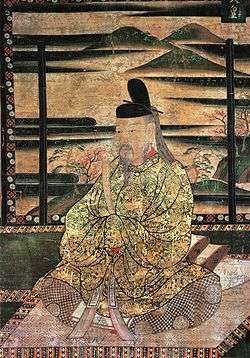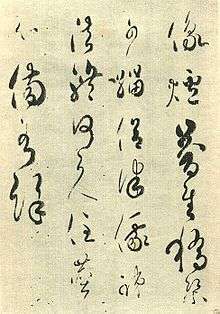Emperor Saga
| Emperor Saga 嵯峨天皇 | |||||
|---|---|---|---|---|---|
 | |||||
| 52nd Emperor of Japan | |||||
| Reign | 18 May 809 – 23 May 823 | ||||
| Predecessor | Emperor Heizei | ||||
| Successor | Emperor Junna | ||||
| Born | 10 October 786 | ||||
| Died | 24 August 842 (aged 55) | ||||
| Burial |
February 24, 1989 Saga no yamanoe no misasagi | ||||
| Spouse | Empress Danrin | ||||
| |||||
| Father | Emperor Kanmu | ||||
| Mother | Fujiwara no Otomuro | ||||

Emperor Saga (嵯峨天皇 Saga-tennō, (October 10, 786 – August 24, 842) was the 52nd emperor of Japan,[1] according to the traditional order of succession.[2] Saga's reign spanned the years from 809 through 823.[3]
Traditional narrative
Saga was the second son of Emperor Kanmu and Fujiwara no Otomuro.[4][5] His personal name was Kamino (神野).[6] Saga was an "accomplished calligrapher" able to compose in Chinese who held the first imperial poetry competitions (naien).[7] According to legend, he was the first Japanese emperor to drink tea.
Saga is traditionally venerated at his tomb; the Imperial Household Agency designates Saganoyamanoe no Misasagi (嵯峨山上陵, Saganoyamanoe Imperial Mausoleum), in Ukyō-ku, Kyoto, as the location of Saga's mausoleum.[1]
Events of Saga's life
- 806 Saga became the crown prince at age 21.
- June 17, 809[8] (Daidō 4, 1st day of the 4th month[9]): In the 4th year of Emperor Heizei's reign, he fell ill and abdicated; and the succession (senso) was received by Kanmu's second son Saga, the eldest son having become a Buddhist priest. Shortly thereafter, Emperor Saga is said to have acceded to the throne (sokui).[10]
Soon after his enthronement, Saga himself took ill. At the time the retired Heizei had quarreled with his brother over the ideal location of the court, the latter preferring the Heian capital, while the former was convinced that a shift back to the Nara plain was necessary, and Heizei, exploiting Saga's weakened health, seized the opportunity to foment a rebellion, known historically as the Kusuko Incident; however, forces loyal to Emperor Saga, led by taishōgun Sakanoue no Tamuramaro, quickly defeated the Heizei rebels which thus limited the adverse consequences which would have followed any broader conflict.[11] This same Tamuramaro is remembered in Aomori's annual nebuta or neputa matsuri which feature a number of gigantic, specially-constructed, illuminated paper floats. These great lantern-structures are colorfully painted with mythical figures; and teams of men carry them through the streets as crowds shout encouragement. This early ninth century military leader is commemorated in this way because he is said to have ordered huge illuminated lanterns to be placed at the top of hills; and when the curious Emishi approached these bright lights to investigate, they were captured and subdued by Tamuramaro's men.[12]
Eras of Saga's reign
The years of Saga's reign are more specifically identified by more than one era name (nengō).[15]
Legacy
In ancient Japan, there were four noble clans, the Gempeitōkitsu (源平藤橘). One of these clans, the Minamoto clan are also known as Genji (源氏), and of these, the Saga Genji (嵯峨源氏) are descended from 52nd emperor Saga. Saga's grandson, Minamoto no Tōru, is thought to be an inspiration for the protagonist of the novel The Tale of Genji.
In the 9th century, Emperor Saga made a decree prohibiting meat consumption except fish and birds and abolished capital punishment in 818. This remained the dietary habit of Japanese until the introduction of European dietary customs in the 19th century.
Emperor Saga played an important role as a stalwart supporter of the Buddhist monk Kūkai. The emperor helped Kūkai to establish the Shingon School of Buddhism by granting him Tō-ji Temple in the capital Heian-kyō (present-day Kyoto).
Kugyō
Kugyō (公卿) is a collective term for the very few most powerful men attached to the court of the Emperor of Japan in pre-Meiji eras.[16]
In general, this elite group included only three to four men at a time. These were hereditary courtiers whose experience and background would have brought them to the pinnacle of a life's career. During Saga's reign (809–823), this kugyō included:
- Sadaijin
- Udaijin, Fujiwara no Uchimaro (藤原内麿), 806–812.[5]
- Udaijin, Fujiwara no Sonohito (藤原園人), 812–818.[5]
- Udaijin, Fujiwara no Fuyutsugu (藤原冬嗣), 821–825.[5]
- Udaijin, Tachibana no Ujikimi.[17]
- Naidaijin
- Dainagon
Consorts and children
Saga had 49 children by at least 30 different women. Many of the children received the surname Minamoto, thereby removing them from royal succession.
Empress: Tachibana no Kachiko (橘嘉智子) (786–850), also known as Empress Danrin (檀林皇后 Danrin-kōgō), daughter of Tachibana no Kiyotomo (橘清友).[18]
- Imperial Prince Masara (正良親王) (810–850), Emperor Ninmyō
- Imperial Princess Masako (正子内親王) (810–879), married to Emperor Junna
- Imperial Princess Hideko (秀子内親王) (d. 850)
- Imperial Prince Hidera (秀良親王) (817–895)
- Imperial Princess Toshiko (俊子内親王) (d. 826)
- Imperial Princess Yoshiko (芳子内親王) (d. 839)
- Imperial Princess Shigeko (繁子内親王) (d. 851)
Hi(deposed): Princess Takatsu (高津内親王) (d. 841), daughter of Emperor Kanmu
- Imperial Prince Nariyoshi (業良親王) (d. 868)
- Imperial Princess Nariko (業子内親王) (d. 815)
Hi: Tajihi no Takako (多治比高子) (787–825), daughter of Tajihi no Ujimori (多治比氏守)
Bunin: Fujiwara no Onatsu (藤原緒夏) (d. 855), daughter of Fujiwara no Uchimaro (藤原内麻呂)
Nyōgo: Ōhara no Kiyoko (大原浄子) (d. 841), daughter of Ōhara no Yakatsugu (大原家継)
- Imperial Princess Ninshi (仁子内親王) (d. 889), 15th Saiō in Ise Shrine 809–823
Nyōgo: Princess Katano (交野女王), daughter of Prince Yamaguchi (山口王)
- Imperial Princess Uchiko (有智子内親王) (807–847), 1st Saiin in Kamo Shrine 810–831
Nyōgo: Kudara no Kimyō (百済貴命) (d. 851), daughter of Kudara no Shuntetsu (百済俊哲)
- Imperial Prince Motora (基良親王) (d. 831)
- Imperial Prince Tadara (忠良親王) (819–876)
- Imperial Princess Motoko (基子内親王) (d. 831)
Koui: Iidaka no Yakatoji (飯高宅刀自)
- Minamoto no Tokiwa (源常) (812–854)
- Minamoto no Akira (源明) (814–852/853)
Koui: Akishino no Koko (秋篠高子/康子), daughter of Akishino no Yasuhito (秋篠安人)
- Minamoto no Kiyoshi (源清)
Koui: Yamada no Chikako (山田近子)
- Minamoto no Hiraku(?) (源啓) (829–869)
- Minamoto no Mituhime (源密姫)
Court lady (Naishi-no-kami): Kudara no Kyomyō (百済慶命) (d. 849), daughter of Kudara no Kyōshun (百済教俊)
- Minamoto no Yoshihime (源善姫)(b. 814)
- Minamoto no Sadamu (源定) (815–863)
- Minamoto no Wakahime (源若姫)
- Minamoto no Shizumu(?) (源鎮) (824–881)
Court lady: Takashina no Kawako (高階河子), daughter of Takashina no Kiyoshina (高階浄階)
- Imperial Princess Sōshi (宗子内親王) (d. 854)
Court lady: Fun'ya no Fumiko (文屋文子), daughter of Fun'ya no Kugamaro (文屋久賀麻呂)
- Imperial Princess Junshi (純子内親王) (d. 863)
- Imperial Princess Seishi (斉子内親王) (d. 853), married to Prince Fujii (son of Emperor Kanmu)
- Prince Atsushi (淳王)
Court lady: A daughter of Hiroi no Otona (広井弟名の娘)
- Minamoto no Makoto (源信) (810–869)
Court lady: Fuse no Musashiko (布勢武蔵子)
- Minamoto no Sadahime (源貞姫) (810–880)
- Minamoto no Hashihime (源端姫)
Court lady: A daughter of Kamitsukeno clan (上毛野氏の娘)
- Minamoto no Hiromu (源弘) (812–863)
Court lady(Nyoju): A daughter of Taima no Osadamaro (当麻治田麻呂の娘)
- Minamoto no Kiyohime (源潔姫) (810–856), married to Fujiwara no Yoshifusa (藤原良房)
- Minamoto no Matahime (源全姫) (812–882), Naishi-no-kami (尚侍)
Court lady: A daughter of Abe no Yanatsu (安部楊津の娘)
- Minamoto no Yutaka(?) (源寛) (813–876)
Court lady: Kasa no Tsugiko (笠継子), daughter of Kasa no Nakamori (笠仲守)
- Minamoto no Ikeru (源生) (821–872)
Court lady: A daughter of Tanaka clan (田中氏の娘)
- Minamoto no Sumu(?) (源澄)
Court lady: A daughter of Awata clan (粟田氏の娘)
- Minamoto no Yasushi (源安) (822–853)
Court lady: Ōhara no Matako (大原全子), daughter of Ōhara no Mamuro (大原真室)
- Minamoto no Tōru (源融) (822–895), Sadaijin
- Minamoto no Tsutomu (源勤) (824–881)
- Minamoto no Mitsuhime (源盈姫)
Court lady: A daughter of Koreyoshi no Sadamichi (惟良貞道の娘)
- Minamoto no Masaru (源勝)
Court lady: A daughter of Nagaoka no Okanari (長岡岡成の娘)
- Minamoto no Sakashi(?) (源賢)
Court lady: A daughter of Ki clan (紀氏の娘)
- Minamoto no Sarahime (源更姫)
Court lady: Kura no Kageko (内蔵影子)
- Minamoto no Kamihime (源神姫)
- Minamoto no Katahime(?) (源容姫)
- Minamoto no Agahime (源吾姫)
Court lady: Kannabi no Iseko (甘南備伊勢子)
- Minamoto no Koehime (源声姫)
Court lady: Tachibana no Haruko (橘春子)
Court lady: Ōnakatomi no Mineko (大中臣峯子)
(from unknown women)
- Minamoto no Tsugu (?) (源継)
- Minamoto no Yoshihime (源良姫)
- Minamoto no Toshihime (源年姫)
See also
Notes

- 1 2 Emperor Saga, Saganoyamanoe Imperial Mausoleum, Imperial Household Agency
- ↑ Ponsonby-Fane, Richard. (1959). The Imperial House of Japan, pp. 63–64.
- ↑ Brown and Ishida, pp. 280–282; Varley, H. Paul. (1980). Jinnō Shōtōki, p. 151–163; Titsingh, Isaac. (1834). Annales des empereurs du Japon, pp. 97–102., p. 97, at Google Books
- ↑ Varley, p. 151.
- 1 2 3 4 Brown and Ishida, p. 280.
- ↑ Titsingh, p. 96; Brown and Ishida, p. 280.
- ↑ Brown and Ishida, p. 281
- ↑ Julian dates derived from NengoCalc
- ↑ 大同四年五月一日
- ↑ Titsingh, p. 96; Brown and Ishida, p. 280; Varley, p. 44; a distinct act of senso is unrecognized prior to Emperor Tenji; and all sovereigns except Jitō, Yōzei, Go-Toba, and Fushimi have senso and sokui in the same year until the reign of Emperor Go-Murakami.
- ↑ Titsingh, p. 98; Varley, p. 151.
- ↑ Boroff, Nicholas. National Geographic Traveler Japan, p. 156.
- ↑ 承和九年七月十五日
- ↑ Brown and Ishida, p. 282; Varley, p. 163.
- ↑ Titsingh, p. 97.
- ↑ Furugosho: kugyō of Saga-tennō
- ↑ Ponsonby-Fane, p. 319.
- ↑ Ponsonby-Fane, Richard. (1959). The Imperial House of Japan, pp. 318–319.
References
嵯峨山上
- Imperial Household Agency (2004). 嵯峨天皇 嵯峨山上 [Emperor Saga, Saganoyamanoe Imperial Mausoleum] (in Japanese). Retrieved February 4, 2011.
- Brown, Delmer M.; Ishida, Ichirō (1979). The Future and the Past (a translation and study of the Gukanshō, an interpretive history of Japan written in 1219). Berkeley: University of California Press. ISBN 978-0-520-03460-0. OCLC 251325323.
- Richard Arthur Brabazon Ponsonby-Fane (1959). The Imperial House of Japan. Ponsonby Memorial Society.
- Rin-siyo, Siyun-zai (1834). Annales des empereurs du Japon. Oriental Translation Fund.
- Chikafuza, Kitabatake (1980). A Chronicle of Gods and Sovereigns: Jinnō Shōtōki of Kitabatake Chikafusa. Columbia University Press. ISBN 978-0-231-04940-5.
External links
| Regnal titles | ||
|---|---|---|
| Preceded by Emperor Heizei |
Emperor of Japan: Saga 809–823 |
Succeeded by Emperor Junna |
